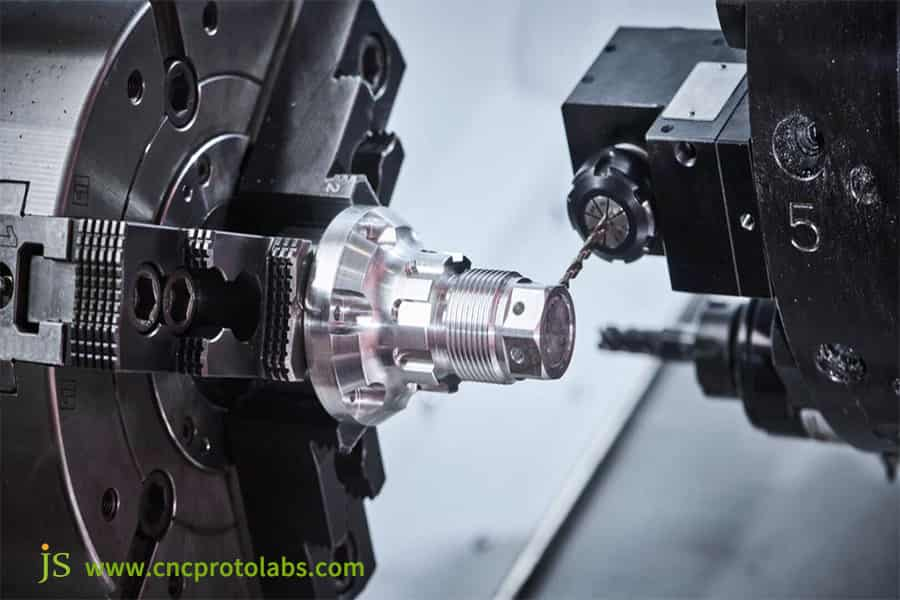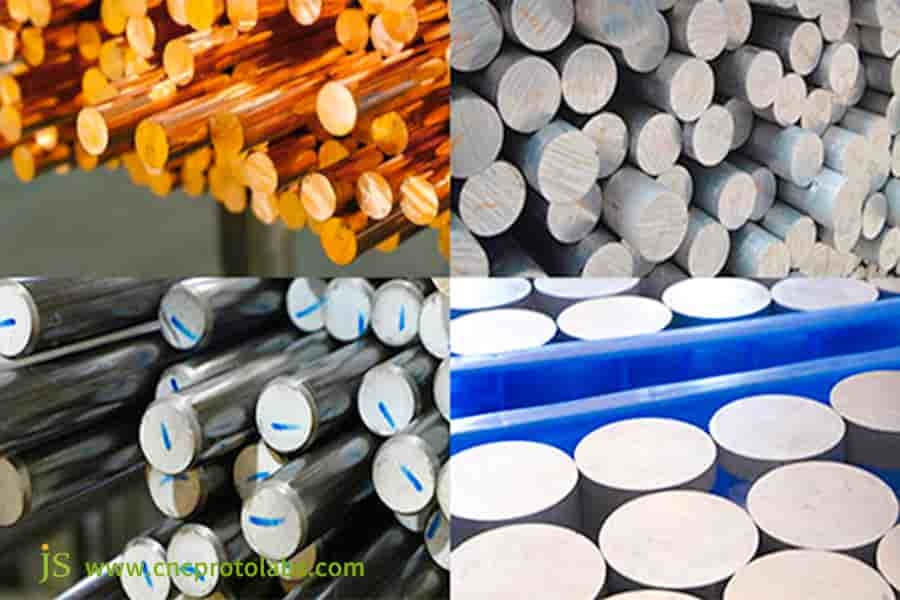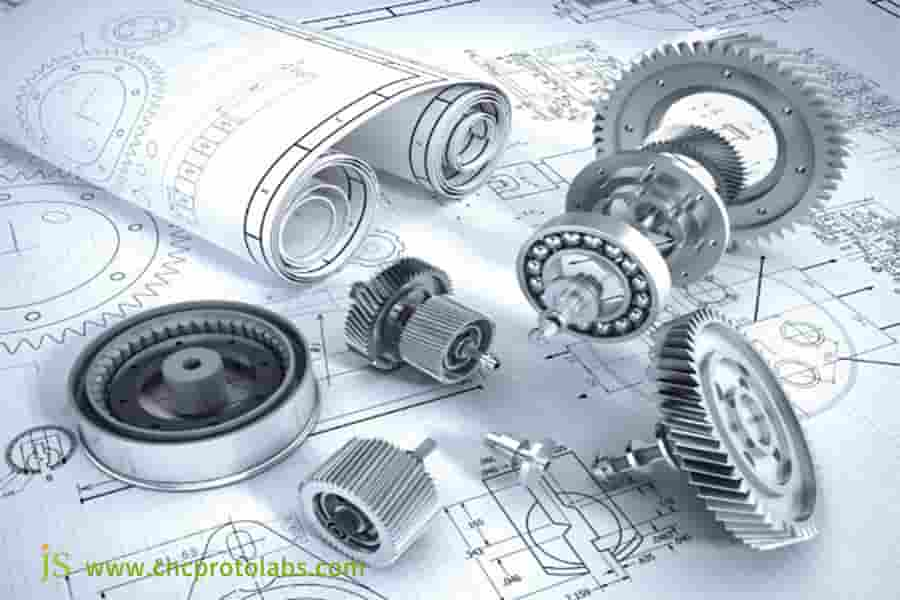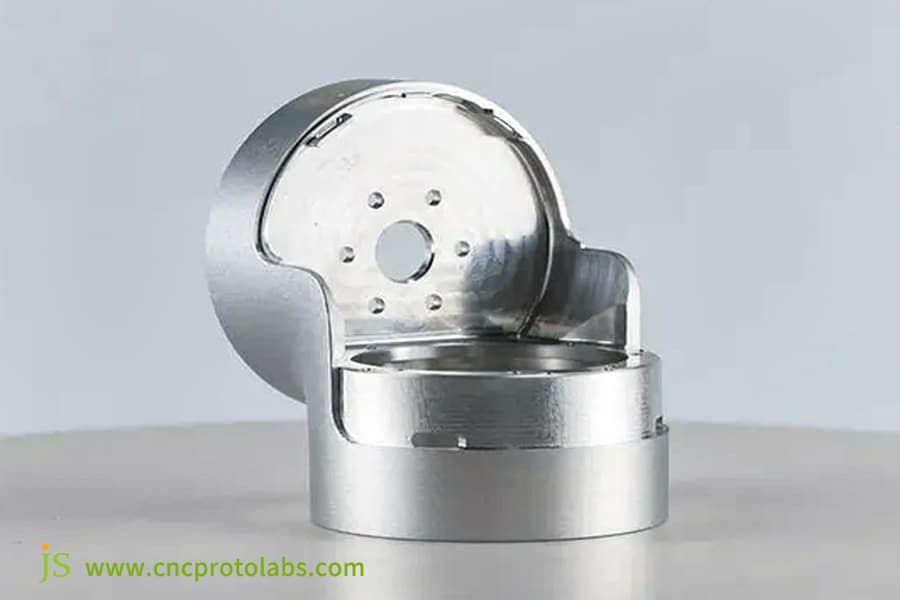In the development of the product in the given time, CNC rapid prototyping is the fastest and strongest link between concept and completed product.But with the visible expense of rapid prototyping, teams will ask: Is it worth it? Can one be cheap and be fast and great too?
The response is yes. Being cost-conscious has absolutely nothing to do with a diminished quality, it is a question of having a very intimate understanding of the manufacturing process and making intelligent choices.
In this essay, each one of the cost drivers will be explored in greater detail, along with practical proposals for optimization, and an explanation for why the choice of JS Precision's online rapid prototyping services is the best means of providing maximum cost-effectiveness for custom rapid prototyping.
Core Answer Summary
| Cost Drivers | Impact on Price | JS Precision Optimization Solutions |
| Material Selection | The material and processability (e.g., hardness) of the material directly affect cost in the quote. | Material Intelligence: Defines the least costly material to satisfy functional demands, avoiding over-performance. |
| Part Size and Volume | Size affects the amount of material used, and volume affects processing time. | Intelligent Layout: Optimizes the layout of many small parts, material shared and waste reduced. |
| Geometric Complexity | Complicated features are more time-consuming to process, require specialized tools, and additional programming time. | Design for Factoring (DFM) Feedback: Actively provides you with design optimization suggestions to minimize processing complexity without affecting functionality. |
| Tolerances and Surface Finish | Exponential cost increase is linked to each level of precision improvement. | Graded Marking: Guides you to define tight tolerances only on critical features, with relaxed requirements on non-critical areas. |
| Quantity | Small series cannot amortize initial programming and setup costs. | Batch Aggregation: Consolidate your prototype requirements over several projects within a single order to reduce the unit costs. |
JS Precision's Basic Plan: Getting The Best Out Of CNC Rapid Prototyping
JS Precision is a 15+ year old company with expertise in CNC rapid prototyping and has worked with over 3,000 customers in over 20 various industries like automobile, medicine, robotics, and consumer electronics.
We have completed over 12,000 Rapid Prototyping orders in the past year alone that varied from high-accuracy surgical tool prototypes for the medical industry to complex component manufacturing for the robotics sector with a record 99.2% project success rate.
Our design engineers carry over eight years of average experience in Design for Manufacturability (DFM) analysis and saved customers over $3 million in cost through design improvement. For example, we optimized a prototype of an auto parts company's transmission component that reduced cost and lead time significantly.
This is a best-practice guide based on detailed case histories of practical real-world experience and technical expertise. Recommended guidance has been tested and applied to actual projects and offer tried-and-tested solutions to the management of rapid prototyping costs.
If you require tried and tested CNC rapid prototyping services, JS Precision can leverage its experience to minimize your cost. You can upload your 3D file, and we will give you an instant DFM report and quote to enable you to advance your project in the right direction.
Digital To Physical: Demystifying The Entire CNC Prototyping Process
Understanding the whole CNC prototyping process can avoid cost trap. Here below, we will unveil the most crucial steps from virtual model to real prototype and illustrate the working logic of CNC rapid prototyping.
Step 1: Digital Blueprint - Upload 3D CAD Model
You will be asked to upload a 3D CAD model in STEP/X_T file format, which will be used as input for CNC rapid prototyping. Our system will pass the model through a check to eliminate geometric flaws (e.g., intersection faces) to avoid possibilities of machining issues and cost overruns, giving us a clean slate for rapid prototyping.
Step 2: Manufacturability Review - (JS Precision's Core Value)
Engineers consider machining cost and complexity design views and provide optimization suggestions (e.g., redraw deep hole shapes and substitute edged corners). Complete optimization can reduce rapid prototyping cost by a significant percentage.
Step 3: Intelligent Programming - Create Efficient Toolpaths
CAM designers construct toolpaths from part geometry and material characteristics in a manner that gives utmost material utilization (scrap minimization) and machining efficiency (tool change minimization) priority. Both these optimizations play important roles in overall cost management.
Step 4: Precision Machining - Cutting with Advanced CNC Machines
We employ high-accuracy CNC cutting machines that may require some tool changes and setup in between. We monitor the process in real time so that scrapping and rework can be eliminated, which saves extra cost and leads to effective rapid prototyping.
Step 5: Post-Processing and Quality Check - After the Digital Model
Perform post-machining processes such as deburring and sandblasting, and dimensional inspection through a coordinate measuring machine after machining. Quality check is performed rigorously against computer-aided design digital model to avoid re-manufacturing due to dimension change and thus save you cost of rapid prototyping parts.
Choosing JS Precision for your custom rapid prototyping manufacturing allows you to enjoy the convenient digital-to-physical process. We oversee the production step by step to maintain compliance at each stage, and you can export quality prototypes with ease and speed.

In-Depth Analysis: Important Factors Setting The Cost Of CNC Prototyping
Having understood the process, it is of utmost significance to establish what directly affects the rapid prototyping price.
Design Complexity: Simplicity Saves Money - The Cost of Complex Component Manufacturing
Parts with complex geometries like deep holes and sharp corners are a part of higher machining complexity, and therefore complex parts are much more expensive than simple parts. The more the deep holes, the higher the increase in price.
Material Selection: Aluminum, Stainless Steel, or PEEK
Procurement cost and machining ease vary greatly across different materials. Materials with low machining difficulty are cheaper, while performance materials, due to higher machining difficulty, are much more expensive than conventional materials.
Tolerances and Finish: The Cost of Ultra-high Precision
The stricter the tolerance requirements and the higher the surface finish, the more additional processing steps and time are required, thereby adding cost. Non critical surfaces do not need to pursue excessively high standards.
Part Size and Volume: Large or Numerous Isn't "More Economical"
More part size demands greater amounts of raw material and machine time, causing a step-wise increase in price. Above some point, unit cost savings diminishes.
Delivery Time: Rush Service Premium
Rush delivery means special equipment and labor priorities, which cost money. The shorter the delivery time, the greater the premium. Preplanning can save these expenses.
Design for Manufacturability (DFM) Driver: Is the Design "Friendly"?
DFM-friendly designs (e.g., through the inclusion of chamfers and lack of deep holes) can reduce the complexity of machining significantly. Small design changes can result in huge cost reductions. For example, changing the hole structure can reduce the utilization of specialty tooling.
| Influencing Factors | Material Type/Parameter Range | Cost Variation Data | Applicable Scenarios |
| Design Complexity | Includes 3 deep holes (>10 times diameter). | 30%-50% more costly than non-deep hole parts. | Complex component manufacturing requires prior optimization of the structure. |
| Material Selection | 6061 aluminum alloy / 304 stainless steel / PEEK. | PEEK is 4-6 times more costly than 6061 aluminum alloy. | Low-cost, easy-machining material should be used for functional tests. |
| Tolerances and Finish | ±0.005mm vs. ±0.05mm, Ra0.8 vs. Ra1.6. | Narrow tolerances are 20%-30% more costly than broad tolerances, Ra0.8 is 15%-25% more costly than Ra1.6. | For non-mating surfaces, choose broad tolerances and standard finishes. |
| Part Size and Volume | 100mm³ vs. 50mm³ | A 100mm³ part is 3-4 times more costly than a 50mm³ part. | Assign part quantity based on actual requirements. |
| Delivery Time | 3 Expedited shipping vs. regular shipping in 7-10 days. | Expedited shipping is 25%-40% higher than regular shipping. | For non-critical applications, choose regular shipping. |
JS Precision can help you analyze the impact of various factors on rapid prototyping price and improved design using Design for Factor Management (DFM). Regardless of how intricate your part is, we can determine the optimal balance between cost and quality.

Cost Analysis: What Are The Factors That Make Up Rapid Prototyping Costs?
Having established the drivers of, it is important to know the precise sources of cost. Rapid prototyping costs are made up of various factors.
1.Material Cost
Material cost includes raw material buying price and cost of loss of scrap. Scrap rate is a function of part layout. Improper layout may lead to increases in scrap rate and material cost.
2.Machine Tool Hours
Machine tool hour costs are the core cost of rapid prototyping covering machine tool depreciation, power, maintenance, and facility usage. It is calculated based on machining time, such that more machining time incurred contributes the cost.
3.Programming and Setup Costs
These include CAM programming time, licenses for software, and first-article commissioning charges. While these are significant for one-piece samples, they can be spread over a series of parts in mass production, reducing unit cost.
4.Post-Processing Costs
These costs are estimated based on the type of surface treatment. Equipment expense and materials are mostly variable for every treatment. Choosing regular treatments for non-appearance parts will reduce these expenses.
5.Management and Quality Inspection Costs
Project management, quality inspection, and packaging and shipping costs are all encompassed within them. Not part of the machining process but crucial to project timelines and prototype quality, they shouldn't be indiscriminately cut.
| Cost Composition | Percentage Range | Specific Costs/Parameter Range | Key Factors Affecting Costs | Cost per $1,000 Order |
| Material Cost | 15-25% | 6061 Aluminum Alloy: $5-8/kg. Scrap Rate: 5-20% | Material Type and Part Layout (Influences Scrap Rate) | $150-250 |
| Machine Hour Cost | 40-50% | Annual Depreciation of an Expensive CNC Machine: Approximately $50,000. Power Utilization: 5-8 kWh/hour. | Machine Type and Processing Time | $400-500 |
| Programming and Setup Cost | 15-20% | Annual CAD/CAM Software License Fee: $10,000-20,000.Engineer Daily Wage: $50-80 | Design Complexity (Affects Programming Time) and Batch Size | $150-200 |
| Post-Processing Cost | 5-10% | Sandblasting: $10-15/㎡. Anodizing: $20-30/㎡. Painting: $30-50/㎡. | Process Type and Part Surface Area | $50-100 |
| Administrative and Quality Inspection Cost | 5-10% | CMM inspection $50-100 per session, packaging and shipping $10-50. | Testing Standard and Shipping Distance | $50-100 |
Redefining Value: Why Rapid Prototyping Is Your Smartest Investment
Controlling the rapid prototyping price is important, but the value of fast prototyping far outweighs the expense. The following four advantages of rapid prototyping demonstrate why it's a smart investment:
1.Reducing the Risk of Gigantic-Scale Failure
Before actually investing in costly tooling, CNC rapid prototyping to check design, function, and assembly ahead of time can avoid mold scrapping due to failure during mass production. This has saved one electronics firm a lot of money in re-production of molds.
2.Speeding Product Time to Market
Rapid prototyping has a short iteration cycle and can quickly optimize prototypes. It is launched several months earlier than projects without prototypes, allowing a smart home company to seize market opportunities and increase first-year sales.
3.Getting Real Product Feedback
User input on high-fidelity physical models is significantly higher in quality than on renderings. Users can give rich input through touch interfaces. A smartphone grip manufacturer optimized its grip design and significantly improved user satisfaction.
4.Optimize Supply Chain and Production
Through rapid prototyping parts testing, production issues (such as processing difficulty) can be identified in advance, optimizing mass production processes. It also evaluate the professionalism of suppliers in the field of custom rapid prototyping manufacturing, and enables you to select best partners for mass production and reduce risks of supplies.
By choosing JS Precision's CNC rapid prototyping service, you can fully enjoy the advantages of rapid prototyping. We help you reduce the risk of failure, accelerate time to market, and get a competitive advantage.
Forward-Looking Horizons: Three Trends Impacting Prototyping Costs In 2025
Understanding future trends will help you plan ahead and be able to control CNC rapid prototyping costs more effectively. The next three trends are predicted for 2025 to allow you to realize cost control advantages:
Trend 1: AI-Powered Smart Quoting and Design for Manufacturing (DFM)
In 2025, AI will automatically recognize design cost pitfalls, create optimization recommendations automatically, and calculate rapid prototyping prices in no time, quoting much faster and improving the accuracy of DFM analysis.
Trend 2: Popularization of Hybrid Manufacturing (CNC + 3D Printing)
For the complex component manufacturing (internal flow path components), hybrid manufacturing (3D printing internal structures + CNC finishing of key locations) will become mainstream, optimizing processing capability and cost, reducing costs by wide margins compared with pure CNC machining.
Trend 3: Cloud Manufacturing Ecosystem Maturity
JS Precision's online rapid prototyping service platform will connect global supply chain and exchange manufacturing capability (to stand-by sites when plant capacity is reached automatically) to avoid long shipping and high-cost costs. It will also facilitate file sharing and tracing and reduce communication costs.
JS Precision is delighted to stay current with the latest trends in the field and utilizing cutting-edge technologies such as AI-generate quotation and hybrid manufacturing in order to offer you even lower-priced online rapid prototyping services. No matter what the future holds, we are able to fulfill your cost-saving requirements.
Proven Cost Saving Strategies: Cost Savings On Rapid Prototyping - Reality
Having understood the value proposition and trends, practices of JS Precision for proven cost-cutting methods to help you save CNC rapid prototyping cost without compromise are as follows:
1.Design Optimization is the Key
- Rounded Corners instead of Sharp Corners: Save wastage of specialty tooling and wear, save machining time.
- Refrain from Deep Cavities: Replace deep cavities with shallow/stepped cavities to save machining and cost.
- Reasonable Thin Walls: Control the thickness of the thin wall within a reasonable range to avoid deformation due to excessive thinness and material consumption due to excessive thickness.
2.Choose technology optimally
- Phase-Selection of Materials: Employ low-cost, low-machining material for functional test and end-use material for durability test in an effort to maintain material cost low.
- Assign Proper Finish: Choose an off-the-shelf finish for non-critical surfaces to conserve additional polishing expense.
3.Take Advantage of Professional Expertise
- Choose a free DFM report service provider, such as JS Precision to uncover cost-saving opportunities at their source.
- Batch Order and Build Up Demand: Create a few rapid prototyping parts at a time, splitting programming expense and reducing unit expense.

Case Study: How JS Precision Saved 42% Of Prototyping Costs In A Robot Joint Project By Design For Manufacturing (DFM)
Customer Pain Points
The customer ordered a difficult-to-machine complex aluminum alloy joint component with deep hole and sharp edge conditions. The non-load carrying regions were not well planned in terms of thickness. Initial rapid prototyping price and lead time were well over budget at the expense of functional test delay.
JS Precision Solution
The team created a Design for Material (DFM) report in 24 hours that enhanced three aspects:
1. Detailed DFM Analysis: Addresses problems such as way too high thickness where there is non-load-carrying area, deep difficult-machining holes, and sharp corners and shows the cost and time impact of those features.
2. Design Optimization Recommendations: Modified thickness in non-load-carrying areas, reduced deep holes with the use of stepped holes, replaced sharp corners with rounded corners, and modified some monolithic structures to modular structures to reduce machining complexity.
3. Reduction of Process and Material: Selected a cost-of-machining-reduced equivalent-performance aluminum alloy, redesigned the part shape to reduce scrap and cost.
End Results
Optimization significantly reduced cost and lead time, and the prototype passed all functional test requirements. The customer can invest savings to purchase additional design cycles to make further improvements in the product performance.
| Comparison Dimensions | Before Optimization | After Optimization | Improvement |
| Cost | $1,200 | $700 | 42% reduction |
| Delivery Time | 14 days | 8 days | 43% improvement |
| Scrap Rate | 15% | 8% | 47% decrease |
| Processing Time | 20 hours | 12 hours | 40% decrease |
| Functional Test Results | Not tested (budget exceeded) | Passed 5,000 joint rotation tests. | All specs met. |
Customer Comment: "JS Precision engineers did the extra work. They were not just machining partners, but R&D partners. Cost savings allowed us to do extra design iterations and improve product performance."

Why JS Precision Is Your Optimal Prototyping Cost Partner?
The choice of a best partner also contributes substantially to managing the cost. This is how JS Precision can help you manage CNC rapid prototyping costs optimally:
1.Technology-Driven Cost Optimization
Not only do we carry out the machining, but we also "design for cost reduction" with innovative software and process experience. Quotes clearly list all costs without hidden costs. You can track progress in real-time through the platform for transparency purposes.
2.Benefits of Scaled Operations
As the most trustworthy online rapid prototyping service provider, our high volume of orders allows us to pass material procurement and equipment costs to divide among ourselves and then pass on directly to our customers for better pricing.
3.One-Stop Solution
From CNC rapid prototyping to small-series manufacturing to complex component manufacturing, we provide one-stop services, allowing you to reduce the cost of overhead of negotiating with many vendors and enhancing the efficiency of coordination.
As TechBullion has focused on, our one-stop service relies on an intelligent platform to significantly improve supply chain efficiency, effectively reducing indirect costs of managing multiple suppliers for customers and making cost control more comprehensive.
FAQs
Q1: Is CNC rapid prototyping or 3D printing cheaper?
It depends on your requirements. For low-volume and low-complexity plastic parts, 3D printing can be more economical. But if your prototypes involve high strength, accuracy, or metal materials, CNC rapid prototyping would be more appropriate and have more competitive prices. Provide us with your file and we will provide you with the most neutral comparison.
Q2: How do you guarantee my design will not leak?
Yes. JS Precision signs a legally binding Non-Disclosure Agreement (NDA) with every client, which commits both parties to maintaining confidentiality in written form. Your design files are stored in an encrypted, secure server accessible at most by the project engineer alone, not even he may have access to them. Intellectual property protection is of paramount concern to us, so feel free to upload your design files with complete ease.".
Q3: In the shortest time, how do I get a quote?
Simply visit JS Precision's web-based rapid prototyping service portal, upload your 3D file (preferably in STEP/X_T format), and input basic information such as part quantity, material needs, tolerance needs, and post-process needs. Our system will provide a clear quote within 30 minutes, with costing of all the factors in detail, so that you can understand at one go the rapid prototyping price.
Q4: Is the process going to be complicated if my design will need some accommodation?
It's very simple. You simply put up an updated version of your file on your project page. The system will recognize the design revisions automatically and generate a change order, which will specifically state the impact of the revisions on price and delivery. Once you've approved the change order, we'll then go ahead with the project right away using the project's updated design.
Summary
CNC rapid prototyping cost management is an art that marries design insight, material science, and manufacturing operations. It takes being a designer and also a astute manufacturing decision-maker. Choosing a deeply engaged, value-oriented manufacturing partner like JS Precision is the greatest single step in your cost reduction program.
No longer do you have to fly solo on these complicated decisions.
Let JS Precision's team of experts provide you with a free cost audit!
Upload your part 3D model today and, along with an easy-to-understand, immediate rapid prototyping price quote, receive a customized Cost Optimization and Design for Manufacturing (DFM) Analysis Report from our experienced engineers, enjoying the convenience and value brought by the advantages of rapid prototyping.
Disclaimer
The contents of this page are for informational purposes only.JS Precision Services,there are no representations or warranties, express or implied, as to the accuracy, completeness or validity of the information. It should not be inferred that a third-party supplier or manufacturer will provide performance parameters, geometric tolerances, specific design characteristics, material quality and type or workmanship through the JS Precision Network. It's the buyer's responsibility Require parts quotation Identify specific requirements for these sections.Please contact us for more information.
JS Precision Team
JS Precision is an industry-leading company, focus on custom manufacturing solutions. We have over 20 years of experience with over 5,000 customers, and we focus on high precisionCNC machining,Sheet metal manufacturing,3D printing,Injection molding,Metal stamping,and other one-stop manufacturing services.
Our factory is equipped with over 100 state-of-the-art 5-axis machining centers, ISO 9001:2015 certified. We provide fast, efficient and high-quality manufacturing solutions to customers in more than 150 countries around the world. Whether it is small volume production or large-scale customization, we can meet your needs with the fastest delivery within 24 hours. Choose JS Precision this means selection efficiency, quality and professionalism.
To learn more, visit our website:www.cncprotolabs.com






